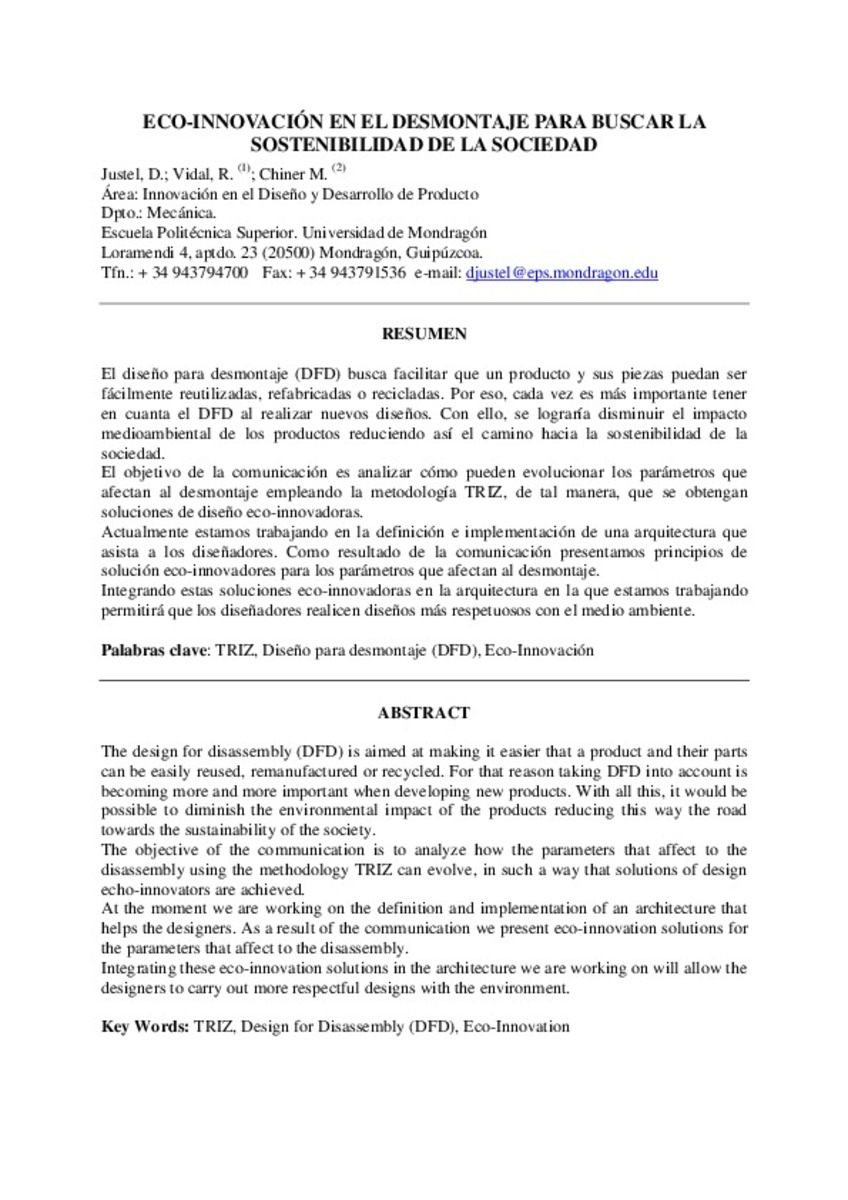| dc.contributor.author | Justel Lozano, Daniel | |
| dc.contributor.author | Vidal, Rosario | |
| dc.contributor.author | Chiner, Mercedes | |
| dc.date.accessioned | 2014-02-04T12:37:09Z | |
| dc.date.available | 2014-02-04T12:37:09Z | |
| dc.date.issued | 2005 | |
| dc.identifier.citation | Justel, D., Vidal, R., Chiner, M. Eco-innovación en el desmontaje para buscar la sostenibilidad de la sociedad. En IX Congreso Internacional de Ingeniería de Proyectos, 2005 Málaga | ca_CA |
| dc.identifier.uri | http://hdl.handle.net/10234/82133 | |
| dc.description | Ponencia presentada en el IX Congreso Internacional de Ingeniería de Proyectos celebrado en Málaga en el año 2005 | ca_CA |
| dc.description.abstract | The design for disassembly (DFD) is aimed at making it easier that a product and their parts
can be easily reused, remanufactured or recycled. For that reason taking DFD into account is
becoming more and more important when developing new products. With all this, it would be
possible to diminish the environmental impact of the products reducing this way the road
towards the sustainability of the society.
The objective of the communication is to analyze how the parameters that affect to the
disassembly using the methodology TRIZ can evolve, in such a way that solutions of design
echo-innovators are achieved.
At the moment we are working on the definition and implementation of an architecture that
helps the designers. As a result of the communication we present eco-innovation solutions for
the parameters that affect to the disassembly.
Integrating these eco-innovation solutions in the architecture we are working on will allow the
designers to carry out more respectful designs with the environment. | ca_CA |
| dc.description.abstract | El diseño para desmontaje (DFD) busca facilitar que un producto y sus piezas puedan ser
fácilmente reutilizadas, refabricadas o recicladas. Por eso, cada vez es más importante tener
en cuanta el DFD al realizar nuevos diseños. Con ello, se lograría disminuir el impacto
medioambiental de los productos reduciendo así el camino hacia la sostenibilidad de la
sociedad.
El objetivo de la comunicación es analizar cómo pueden evolucionar los parámetros que
afectan al desmontaje empleando la metodología TRIZ, de tal manera, que se obtengan
soluciones de diseño eco-innovadoras.
Actualmente estamos trabajando en la definición e implementación de una arquitectura que
asista a los diseñadores. Como resultado de la comunicación presentamos principios de
solución eco-innovadores para los parámetros que afectan al desmontaje.
Integrando estas soluciones eco-innovadoras en la arquitectura en la que estamos trabajando
permitirá que los diseñadores realicen diseños más respetuosos con el medio ambiente. | ca_CA |
| dc.format.extent | 10 p. | ca_CA |
| dc.format.mimetype | application/pdf | ca_CA |
| dc.language.iso | spa | ca_CA |
| dc.publisher | Asociación Española de Dirección e Ingeniería de Proyectos (AEIPRO) | ca_CA |
| dc.rights.uri | http://rightsstatements.org/vocab/CNE/1.0/ | * |
| dc.subject | TRIZ | ca_CA |
| dc.subject | Design for Disassembly (DFD) | ca_CA |
| dc.subject | Eco-Innovation | ca_CA |
| dc.subject | Diseño para desmontaje (DFD) | ca_CA |
| dc.subject | Eco-Innovación | ca_CA |
| dc.title | Eco-innovación en el desmontaje para buscar la sostenibilidad de la sociedad | ca_CA |
| dc.type | info:eu-repo/semantics/article | ca_CA |
| dc.rights.accessRights | info:eu-repo/semantics/openAccess | ca_CA |
| dc.relation.publisherVersion | http://aeipro.com/index.php/es/repository/congresos/congresos_malaga2005/congresos_malaga2005_CIIP05_1002_1496/%20Eco-Innovaci%C3%B3n-En-El-Desmontaje-Para-Buscar-La-Sostenibilidad-De-La-Sociedad/ | ca_CA |







